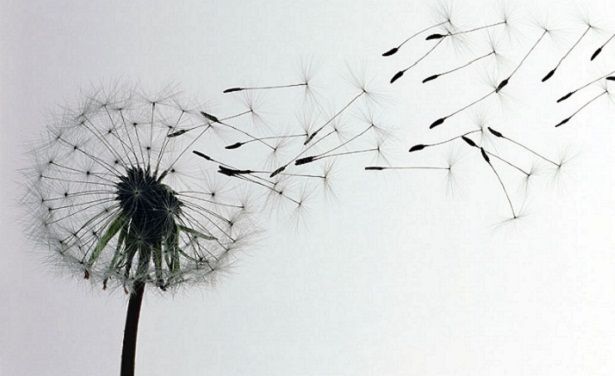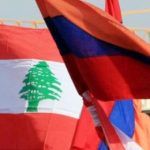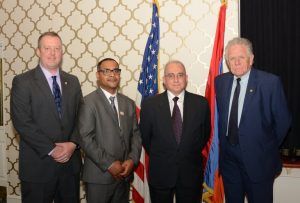Syrian-Armenians presenting works made with their “golden hands” at charity exhibition-sale

On March 6, the vestibule of the Faculty of Armenian Philology at Yerevan State University hosted the opening ceremony of the “Breath of Syrian-Armenian Culture in Yerevan” charity exhibition-sale, which is organized by the RA Ministry of Diaspora and the Center for Coordination of Syrian-Armenians’ Issues NGO. We locals have grown to love and have a desire for the handicraft works, as well as dishes and spices made and prepared by the gifted Syrian-Armenians. No matter how ordinary all this has become for us throughout the past years, the talent of our Syrian-Armenian compatriots continues to amaze and charm us. This is one of the many exhibition-sales where I meet our compatriots and truly enjoy the breath of Syrian-Armenian culture that I gladly share with the readers of Hayern Aysor.
Nazareth Aroian: We are content and are thankful to God. We have more buyers on the first day. The main buyers are students, particularly female students. They pay more attention to rings and bracelets. Since the exhibition-sale is organized at Yerevan State University, a lot of people don’t know about the exhibition. It would be nice, if mass media outlets provided a lot of coverage of this event.
Zohrab Derderian: I was a travel agent in Aleppo, but this is what I am doing in Armenia. People mainly buy beads, and the main buyers are boys. We purchase products from one another. We mainly buy food. Thank God, there are things that are hand-made, and there are other things that I have brought from Aleppo.
Raffi and Ioland Rshtunis: The girls buy more than the boys. They buy gifts for the boys. It appears that they really like the boys and give it to them cordially. We have participated in 30 exhibitions, but this is the third time we are participating in this exhibition-sale at the university.
Vani Arabian: I made all the salty and sweet dishes that you see on this table. It is no secret that Syrian-Armenians can work well with their hands. This comes from Western Armenia and our roots. Students like the salty pies made with Syrian spices. They buy kadaef a lot. The Syrian-Armenian participants of the exhibition also make purchases when they are hungry. Syrian-Armenians know these dishes, and so they buy them with pleasure. Business is good today, thank God!
Noubar and Emanuel Dolmajian: We mainly sell salty pies since the students purchase them the most. This is what we are doing today. I was a school principal and an English language specialist in Aleppo. I was teaching at a pre-school. My wife, Noubar was a housewife. We have been living in Armenia for one-and-a-half year. We have two sons, and they are both computer graphic designers. My younger son has been living here for six years. He had come to refine his vocal chords. He also participated in the “Folk Singer” TV competition. My elder son is married and has a son. We named him Balik and named our products after him.
Vanya Kadehchian: I made my products. It is always necessary to be able to work with your hands. If a person isn’t able to earn a living by his profession due to circumstances, he can always earn a living by working with his hands.
Zarmine Tokatlian-Minasian: We have given an interview to you before, and now I must say that our business is growing. I make these dishes with my husband. You know that we have a store where we sell products that can be used to cook the chicken meals of Aleppo. We have an area and are doing business, and people already know us. We also participate in exhibition-sales. Thank God!
Ani Shamlian: My sister, Lena and I gave an interview to you a long time ago, and you have seen our hand-made items. Today I am presenting pastries that I made myself and am selling them at affordable prices. The students gladly buy them.
Aida Santourian: It took me months to make these items. It is very time-consuming. I mainly sell small bags. I have been living in Armenia and participating in exhibitions for three years. I have met many people who have become my permanent clients.
Lena Jenanian: It takes a lot of effort to make these embroidered items because they are like miniature paintings. This means that they are also expensive. I feel great in Armenia. Even if peace is established in Syria, we won’t return. My husband also works as a laser specialist. My two children attend School #71, and I also have a one-and-a-half year old child.
Nazan Manoukian: I moved from Syria two years ago. This is the third time I am participating in this exhibition-sale. Business isn’t going too well. People are mainly buying humus, halva and spices. We hope we have more customers during the second half of the day.
Huri Ijian: This is the first time I am participating in the exhibition-sale organized by the Ministry of Diaspora. These are my hand-made items. My parents and grandparents also embroidered items. My family is from Aintab. I studied the embroidery of Aintab, Urfa, Van and Svaz and am showcasing my works at this exhibition.
My last interviewee is Nayiri Meguerditchian, who moved from Kamishli to Armenia many years before the Syrian war and is currently working at the RA Ministry of Diaspora. She had come to the exhibition-sale to make purchases, and I talked to her on that occasion.
Karine Avagyan: Nayiri, all these works are surely familiar to you. Which of the familiar dishes do you prefer the most and what will you be purchasing?
Nayiri Meguerditchian: I want to by manti. My daughter loves it. It is so tasty that there is no more manti left. I am waiting for Mrs. Zarmine’s husband to bring manti for me.
Karine Avagyan: Can you prepare manti?
Nayiri Meguerditchian: No! The people of Aleppo make it, and it is like making a bead.
Karine Avagyan: What famous food of Kamishli do you remember? Can you make it?
Nayiri Meguerditchian: Kebab with eggplant, but it is very hard to make. The eggplants in Kamishli are a different kind of eggplant. They don’t have seeds, but they are very tasty. Overall, all the dishes and pastries of the Syrian-Armenians have a unique smell and taste. This is the greatest wealth that the Armenian women of Western Armenia inherited.
I bid farewell to all the participants of the exhibition-sale, wishing them a nice day and good business and that the culture of Syrian-Armenians and the works of Syrian-Armenians that don’t seem to be hand-made, are also showcased at international exhibitions.
Karine Avagyan




 Արևելահայերեն
Արևելահայերեն Արևմտահայերեն
Արևմտահայերեն Русский
Русский






